Old Israeli shekel
The old Israeli shekel, then known as the shekel (Hebrew: שקל, formally sheqel, pl. שקלים, Sheqalim; Arabic: شيكل, šikal) was the currency of the State of Israel between 24 February 1980 and 31 December 1985. It was replaced by the Israeli new shekel at a ratio of 1000:1 on 1 January 1986. The old shekel was short-lived due to its hyperinflation. The old shekel was subdivided into 100 new agorot (אגורות חדשות). The shekel sign was ![]()
| Israeli shekel | |
|---|---|
| שקל (Hebrew) شيكل (Arabic) | |
 IS1000 banknote (obverse and reverse) issued in 1983 | |
| ISO 4217 | |
| Code | ILR |
| Denominations | |
| Subunit | |
| 1/100 | new agora |
| Plural | shqalim |
| new agora | new agorot |
| Symbol | |
| Banknotes | IS1, IS5, IS10, IS50, IS100, IS500, IS1000, IS5000, IS10,000 |
| Coins | 1, 5, 10 new agorot, IS½, IS1, IS5, IS10, IS50, IS100 |
| Demographics | |
| User(s) | |
| Issuance | |
| Central bank | Bank of Israel |
| Website | www |
| Valuation | |
| Inflation | 1000% (1984) |
This infobox shows the latest status before this currency was rendered obsolete. | |
The Israeli old shekel replaced the Israeli pound, which had been used until 24 February 1980, at the rate of 1 shekel to 10 pounds.
History
Development of a new currency to be known as the shekel (properly, sheqel) was approved by the Israeli Knesset on 4 June 1969. The governors of the Bank of Israel did not consider the time ripe until November 1977, when studies for its implementation began. Prime Minister Menachem Begin and Minister of Finance Simcha Erlich approved a proposal to redenominate the Israeli pound in May 1978; the proposal called for the currency to be exactly similar except for the removal of a zero from the inflated pound and agorot denominations.[1]
The shekel and new agora became legal tender on 22 February 1980 and went into circulation two days later. Initial denominations were IS 1, 5, 10, and 50, but over the next five years inflation led to another five: IS 100, 500, 1000, 5000, and 10 000.[1] New coin and bill designs were selected through competitions among graphic designers.[2] Beginning with the IS 500 issue, the size of the notes was standardized (76 mm × 138 mm or 3 in × 5 in) and the denominations differentiated by color and design. A transparent part was added to discourage counterfeiting and elements for the blind were added.[1]
The new Israeli shekel replaced the shekel following its hyperinflation and the enactment of the economic stabilization plan of 1985 which brought inflation under control. It became the currency of Israel on 4 September 1985, removing three zeros from the old notes.[3]
The old shekel is no longer in circulation, has been demonetized, and is not exchangeable to current legal tender by the Bank of Israel.
Coins
The initial series of coins in 1980 were for the denominations of 1, 5, and 10 new agorot and IS ½. These preserved the appearance of the similar coins under the pound but were worth 10 times as much. The initial runs were struck at foreign mints in order to preserve the secrecy of the coming currency conversion. IS 1 coins were introduced in 1981; IS 5 and 10 coins in 1982; and IS 50 and 100 coins in 1984.[2]
The 1 and 5 new agorot coins were aluminum; the 10 new agorot and IS ½, 1, and 100 coins cupronickel; the IS 5 and 50 coins an alloy of copper, aluminum, and nickel; and the IS 10 cupro-aluminum.[2]
| Image | Value | Technical parameters | Description | Date of | ||||
|---|---|---|---|---|---|---|---|---|
| Diameter (mm) | Mass (g) | Composition | Obverse | Reverse | issue | withdrawal | ||
 |
1 new agora | 15 | 0.6 | aluminium 97%, magnesium 3% | Palm tree, "Israel" in Hebrew and Arabic | Value, date | 24.02.1980 |
04.09.1986 |
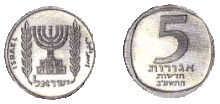 |
5 new agorot | 18.5 | 0.9 | The state emblem, "Israel" in Hebrew, Arabic and English | ||||
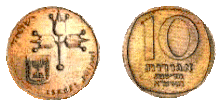 |
10 new agorot | 16 | 2.1 | copper 92%, nickel 8% | Three pomegranates, the state emblem, "Israel" in Hebrew, Arabic and English | |||
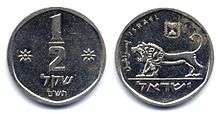 |
IS½ | 20 | 3 | copper 75%, nickel 25% | Lion, the state emblem, "Israel" in Hebrew, Arabic and English | Value, date, two stars | ||
 |
IS1 | 23 | 5 | Cup, "Shekel" in Hebrew | Value, date, the state emblem, "Israel" in Hebrew, Arabic and English | 22.01.1981 | ||
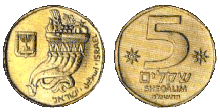 |
IS5 | 24 | 6 | copper 92%, aluminium 6%, nickel 2% | Two cornucopia, the state emblem, "Israel" in Hebrew, Arabic and English | Value, date, two stars | 10.09.1981 | |
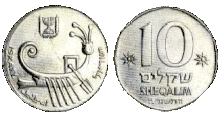 |
IS10 | 26 | 8 | copper 75%, aluminium 25% | Ancient galley, the state emblem, "Israel" in Hebrew, Arabic and English | 25.02.1982 | ||
 |
IS50 | 28 | 9 | copper 92%, aluminium 6%, nickel 2% | Replica of a coin, the state emblem, "Israel" in Hebrew, Arabic and English | 08.03.1984 | ||
 |
IS100 | 29 | 10.8 | copper 75%, nickel 25% | Replica of a coin issued by Antigonus II Mattathias with the seven-branched candelabrum, the state emblem, "Israel" in Hebrew, Arabic and English | Value, date | 02.05.1984 | |
| For table standards, see the coin specification table. | ||||||||
- Note that all dates on Israeli coins are given in the Hebrew calendar and are written in Hebrew numerals.
Banknotes
The initial series of banknotes in 1980 were for the denominations of IS 1, 5, 10, and 50 and preserved the appearance of the 10, 50, 100 and 500-pound notes which they replaced.[1]
Subsequent issues added the denominations of IS 100, 500, 1000, 5000, and 10 000.[1]
| Value | Size | Color | Observe | Reverse | Image | Issued | Withdrawn |
|---|---|---|---|---|---|---|---|
| IS1 | 135×76 mm | purple | Moses Montefiore with Mishkenot Sha'ananim in background | Jaffa Gate |  | 24 February 1980 | 4 September 1986 |
| IS5 | 141×76 mm | green | Chaim Weizmann, Weizmann Institute of Science in background | Damascus Gate | 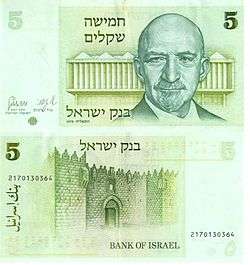 | ||
| IS10 | 147×76 mm | blue | Theodor Herzl, entrance to Mount Herzl in background | Zion Gate |  | ||
| IS50 | 153×76 mm | Ivory-Brown | David Ben-Gurion at the library in Sde Boker | Golden Gate | 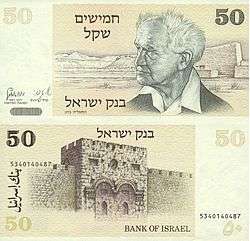 | ||
| IS100 | 159×76 mm | Orange-brown | Ze'ev Jabotinsky | Herod's Gate |  | 11 December 1980 | |
| IS500 | 138×76 mm | red | Edmond James de Rothschild, and farmers | Bunch of grapes |  | 1 December 1982 | |
| IS1000 | green | Maimonides | Tiberias where Maimonides is buried; Ancient stone lamp |  | 17 November 1983 | ||
| IS5,000 | blue | Levi Eshkol | Pipe carrying water, symbolizing the national carrier, fields and barren land in background | 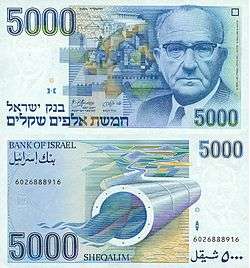 | 9 August 1984 | ||
| IS10,000 | orange | Golda Meir | Picture of Golda Meir in the crowd, in front of the Moscow Choral Synagogue, as she arrived in Moscow as Israel's ambassador in 1948 | 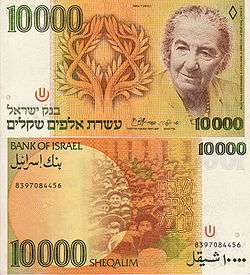 | 27 November 1984 |
See also
References
Citations
- "Past Notes &Coin Series: Sheqel Series", Currency, Bank of Israel.
- "Past Notes &Coin Series: New Agora and Sheqel Series", Currency, Bank of Israel.
- "Past Notes &Coin Series: First Series of the New Sheqel", Currency, Bank of Israel.
Bibliography
- Krause, Chester L.; Clifford Mishler (1991). Standard Catalog of World Coins: 1801–1991 (18th ed.). Krause Publications. ISBN 0873411501.
- Pick, Albert (1994). Standard Catalog of World Paper Money: General Issues. Colin R. Bruce II and Neil Shafer (editors) (7th ed.). Krause Publications. ISBN 0-87341-207-9.
External links
| Wikimedia Commons has media related to Old Israeli shekel. |